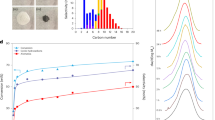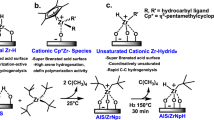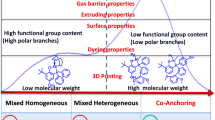Abstract
The overconsumption of single-use plastics is creating a global waste catastrophe, with widespread environmental, economic and health-related consequences. Here we show that the benefits of processive enzyme-catalysed conversions of biomacromolecules can be leveraged to affect the selective hydrogenolysis of high-density polyethylene into a narrow distribution of diesel and lubricant-range alkanes using an ordered, mesoporous shell/active site/core catalyst architecture that incorporates catalytic platinum sites at the base of the mesopores. Solid-state nuclear magnetic resonance revealed that long hydrocarbon macromolecules readily move within the pores of this catalyst, with a subsequent escape being inhibited by polymer–surface interactions, a behaviour that resembles the binding and translocation of macromolecules in the catalytic cleft of processive enzymes. Accordingly, the hydrogenolysis of polyethylene with this catalyst proceeds processively to yield a reliable, narrow and tunable stream of alkane products.

This is a preview of subscription content, access via your institution
Access options
Access Nature and 54 other Nature Portfolio journals
Get Nature+, our best-value online-access subscription
$29.99 / 30 days
cancel any time
Subscribe to this journal
Receive 12 digital issues and online access to articles
$119.00 per year
only $9.92 per issue
Buy this article
- Purchase on Springer Link
- Instant access to full article PDF
Prices may be subject to local taxes which are calculated during checkout






Similar content being viewed by others
Data availability
Transmission electron microscopy, powder X-ray diffraction data and N2 sorption isotherms acquired to characterize inorganic materials, atomic coordinations from density functional theory calculations, NMR spectra and chromatography data that support the findings of this study are available in DataShare53 with the identifier https://doi.org/10.25380/iastate.12685775.
References
Cornell, D. D. Plastics recycling: an overview. ACS Symp. Ser. 609, 72–79 (1995).
Hopewell, J., Dvorak, R. & Kosior, E. Plastics recycling: challenges and opportunities. Phil. Trans. R. Soc. B 364, 2115–2126 (2009).
Garcia, J. M. Catalyst: design challenges for the future of plastics recycling. Chem. 1, 813–819 (2016).
Vollmer, I. et al. Beyond mechanical recycling: giving new life to plastic waste. Angew. Chem. Int. Ed. 59, 15402–15423 (2020).
Boaen, N. K. & Hillmyer, M. A. Post-polymerization functionalization of polyolefins. Chem. Soc. Rev. 34, 267–275 (2005).
Pol, V. G. Upcycling: converting waste plastics into paramagnetic, conducting, solid, pure carbon microspheres. Environ. Sci. Technol. 44, 4753–4759 (2010).
Wu, C., Nahil, M. A., Miskolczi, N., Huang, J. & Williams, P. T. Processing real-world waste plastics by pyrolysis-reforming for hydrogen and high-value carbon nanotubes. Environ. Sci. Technol. 48, 819–826 (2014).
Fonseca, W. S., Meng, X. & Sheng, D. Trash to treasure: transforming waste polystyrene cups into negative electrode materials for sodium ion batteries. ACS Sustainable Chem. Eng. 3, 2153–2159 (2015).
Geiselhart, C. M., Offenloch, J. T., Mutlu, H. & Barner-Kowollik, C. Polybutadiene functionalization via an efficient avenue. ACS Macro Lett. 5, 1146–1151 (2016).
Easterling, C. P., Kubo, T., Orr, Z. M., Fanucci, G. E. & Sumerlin, B. S. Synthetic upcycling of polyacrylates through organocatalyzed post-polymerization modification. Chem. Sci. 8, 7705–7709 (2017).
Bäckström, E., Odelius, K. & Hakkarainen, M. Trash to treasure: microwave-assisted conversion of polyethylene to functional chemicals. Int. Eng. Chem. Res. 56, 14814–14821 (2017).
Okan, M., Aydin, H. M. & Barsbay, M. Current approaches to waste polymer utilization and minimization: a review. J. Chem. Technol. Biotechnol. 94, 8–21 (2019).
Bunescu, A., Lee, S., Li, Q. & Hartwig, J. F. Catalytic hydroxylation of polyethylenes. ACS Cent. Sci. 3, 895–903 (2017).
Bae, C. et al. Regiospecific side‐chain functionalization of linear low‐density polyethylene with polar groups. Angew. Chem. Int. Ed. 44, 6410–6413 (2005).
Jia, X., Qin, C., Friedberger, T., Guan, Z. & Huang, Z. Efficient and selective degradation of polyethylenes into liquid fuels and waxes under mild conditions. Sci. Adv. 2, e1501591 (2016).
Dufaud, V. & Basset, J. –M. Catalytic hydrogenolysis at low temperature and pressure of polyethylene and polypropylene to diesels or lower alkanes by a zirconium hydride supported on silica–alumina: a step toward polyolefin degradation by the microscopic reverse of Ziegler–Natta polymerization. Angew. Chem. Int. Ed. 37, 806–810 (1998).
Gokhan, C. et al. Upcycling single-use polyethylene into high-quality liquid products. ACS Cent. Sci. 5, 1795–1803 (2019).
Suno, R. et al. Structure of the whole cytosolic region of ATP-dependant protease FtsH. Mol. Cell 22, 575–585 (2006).
Mastny, M. et al. CtpB assembles a gated protease tunnel regulating cell–cell signaling during spore formation in Bacillus subtilis. Cell. 155, 647–658 (2013).
Divne, C. et al. The three-dimensional crystal structure of the catalytic core of cellobiohydrolase I from Trichoderma reesei. Science 265, 524–528 (1994).
Rouvinen, T., Bergfors, T., Teeri, T., Knowles, J. K. C. & Jones, T. A. Three-dimensional structure of cellobiohydrolase II from Trichoderma reesei. Science 249, 380–386 (1990).
Austin, H. P. et al. Characterization and engineering of a plastic-degrading aromatic polyesterase. Proc. Natl Acad. Sci. USA 115, E4350–E4357 (2018).
Han, X. et al. Structural insight into catalytic mechanism of PET hydrolase. Nat. Commun. 8, 2106 (2017).
Joo, S. et al. Structural insight into molecular mechanism of poly(ethylene terephthalate) degradation. Nat. Commun. 9, 382 (2018).
Payne, C. M. et al. Fungal cellulases. Chem. Rev. 115, 1308–1448 (2015).
Breyer, W. A. & Matthews, B. W. A structural basis for processivity. Protein Sci. 10, 1699–1711 (2001).
Odian, G. G. Principles of Polymerization 4th edn (Wiley, 2004).
Inoue, D., Kurosu, H., Chen, Q. & Ando, I. Structural and dynamical studies of 13C-labeled polyethylene adsorbed on the surface of silica gel by high-resolution solid-state 13C NMR spectroscopy. Acta Polymer. 46, 420–423 (1995).
Tonelli, A. E. & Schilling, F. C. Calculated carbon-13 nuclear magnetic resonance chemical shifts for ethylene–vinyl chloride copolymers. Macromolecules 14, 74–76 (1981).
Tonelli, A. E. & Schilling, F. C. 13C NMR chemical shifts and the microstructure of polymers. Acc. Chem. Res. 14, 233–238 (1981).
Gao, W. & Reven, L. Solid-state NMR studies of self-assembled monolayers. Langmuir 11, 1860–1863 (1995).
Schmidt-Rohr, K. & Spiess, H. W. Chain diffusion between crystallized and amorphous regions in polyethylene detected by 2D exchange 13C NMR. Macromolecules 24, 5288–5293 (1991).
Frisch, H. L. & Mark, J. E. Nanocomposites prepared by threading polymer chains through zeolites, mesoporous silica, or silica nanotubes. Chem. Mater. 8, 1735–1738 (1996).
Duan, P. et al. Polymer infiltration into metal–organic frameworks in mixed-matrix membranes detected in situ by NMR. J. Am. Chem. Soc. 141, 7589–7595 (2019).
Lin, V. S.-Y. et al. Oxidative polymerization of 1,4-diethynylbenzene into highly conjugated poly(phenylene butadiynylene) within the channels of surface-functionalized mesoporous silica and alumina materials. J. Am. Chem. Soc. 124, 9040–9041 (2002).
Blum, F. D., Xu, G., Liang, M. & Wade, C. G. Dynamics of poly(vinyl acetate) in bulk and on silica. Macromolecules 29, 8740–8745 (1996).
Lin, W.-Y. & Blum, F. D. Segmental dynamics of bulk and adsorbed poly(methyl acrylate)-d3 by deuterium NMR: effect of adsorbed amount. Macromolecules 30, 5331–5338 (1997).
Bax, A., Freeman, R. & Kempsell, S. P. Natural abundance 13C–13C coupling observed via double-quantum coherence. J. Am. Chem. Soc. 102, 4849–4851 (1980).
Lesage, A., Auger, C., Caldarelli, S. & Emsley, L. Determination of through-bond carbon–carbon connectivities in solid-state NMR using the INADEQUATE experiment. J. Am. Chem. Soc. 119, 7867–7868 (1997).
Earl, W. L. & VanderHart, D. L. Observations in solid polyethylenes by carbon-13 nuclear magnetic resonance with magic angle sample spinning. Macromolecules 12, 763–767 (1979).
Kitamaru, R., Horii, F. & Murayama, K. Phase structure of lamellar crystalline polyethylene by solid-state high-resolution 13C NMR: detection of the crystalline–amorphous interphase. Macromolecules 19, 637–643 (1986).
Pearson, D. S., Ver Strate, G., von Meerwall, E. & Schilling, F. C. Viscosity and self-diffusion coefficient of linear polyethylene. Macromolecules 20, 1133–1141 (1987).
Flaherty, D. W. & Iglesia, E. Transition-state enthalpy and entropy effects on reactivity and selectivity in hydrogenolysis of n-alkanes. J. Am. Chem. Soc. 135, 18586–18599 (2013).
Xiao, C. X. et al. High-temperature-stable and regenerable catalysts: platinum nanoparticles in aligned mesoporous silica wells. ChemSusChem 6, 1915–1922 (2013).
Dong, B. et al. In situ quantitative single-molecule study of dynamic catalytic processes in nanoconfinement. Nat. Catal. 1, 135–140 (2018).
Burange, A. S., Gawande, M. B., Lam, F. L. Y., Jayaram, R. V. & Luque, R. Heterogeneously catalyzed strategies for the deconstruction of high density polyethylene: plastic waste valorisation to fuels. Green Chem. 17, 146–156 (2015).
Liu, F. et al. A comparison of NiMo/Al2O3 catalysts prepared by impregnation and coprecipitation methods for hydrodesulfurization of dibenzothiophene. J. Phys. Chem. C 111, 7396–7402 (2007).
Speight, J. G. Handbook of Petroleum Product Analysis 2nd edn 1–25 (Wiley, 2014).
Deng, Y. et al. Multifunctional mesoporous composite microspheres with well-designed nanostructure: a highly integrated catalyst system. J. Am. Chem. Soc. 132, 8466–8473 (2010).
Harris, R. K. et al. Further conventions for NMR shielding and chemical shifts. Pure Appl. Chem. 80, 59–84 (2008).
Bielecki, A. & Burum, D. P. Temperature dependence of 207Pb MAS spectra of solid lead nitrate. An accurate, sensitive thermometer for variable-temperature MAS. J. Magn. Reson. A 116, 215–220 (1995).
Wang, F. C.-Y. & Zhang, L. Chemical composition of group II lubricant oil studied by high-resolution gas chromatography and comprehensive two-dimensional gas chromatography. Energy Fuels 21, 3477–3483 (2007).
Tennakoon, A. et al. Data from ‘Catalytic Upcycling of High Density Polyethylene via a Processive Mechanism’ (DataShare Repository, Iowa State University); https://doi.org/10.25380/iastate.12685775
Maricq, M. M. & Waugh, J. S. NMR in rotating solids. J. Chem. Phys. 70, 3300–3316 (1979).
Acknowledgements
This research is sponsored by the Catalysis for Polymer Upcycling, a project funded by the US Department of Energy (DOE), Office of Basic Energy Sciences, Division of Chemical Sciences, Geosciences, and Biosciences, under Contract Numbers DE-AC-02-07CH11358 (Ames Laboratory) and DE-AC-02- 06CH11357 (Argonne National Laboratory). The authors thank the members of the Catalysis for Polymer Upcycling team, in particular S. Han, T. Keller, K. Poeppelmeier and R. Kennedy for numerous fruitful discussions.
Author information
Authors and Affiliations
Contributions
F.A.P. and A.L.P. conducted the SSNMR experiments under the direction of F.A.P., using *PE prepared and adsorbed onto mSiO2 by S.P. with guidance from G.W.C., A.M.L. and A.D.S. Silica materials and catalysts were prepared by X.W. and Y.P., under the direction of W.H. and I.I.S. A.T. performed the catalytic tests, under the direction of A.D.S. GPC experiments were performed by A.M.L. Product analysis was performed by A.T., R.A.H. and M.D. Signatures of processivity were proposed by B.P. Density functional theory calculations were performed by S.C.A. and A.H. F.A.P., W.H. and A.D.S. composed the manuscript with contributions from all the other co-authors.
Corresponding authors
Ethics declarations
Competing interests
The authors declare no competing interests.
Additional information
Publisher’s note Springer Nature remains neutral with regard to jurisdictional claims in published maps and institutional affiliations.
Supplementary information
Supplementary Information
Supplementary methods, Tables 1–11 (N2 sorption, GPC data and GC data), discussion, Figs. (1–112) and references.
Supplementary Data
XYZ coordinates of optimized DFT structures.
Rights and permissions
About this article
Cite this article
Tennakoon, A., Wu, X., Paterson, A.L. et al. Catalytic upcycling of high-density polyethylene via a processive mechanism. Nat Catal 3, 893–901 (2020). https://doi.org/10.1038/s41929-020-00519-4
Received:
Accepted:
Published:
Issue Date:
DOI: https://doi.org/10.1038/s41929-020-00519-4
This article is cited by
-
Solar reforming as an emerging technology for circular chemical industries
Nature Reviews Chemistry (2024)
-
Upcycling of polyethylene to gasoline through a self-supplied hydrogen strategy in a layered self-pillared zeolite
Nature Chemistry (2024)
-
Two-step conversion of polyethylene into recombinant proteins using a microbial platform
Microbial Cell Factories (2023)
-
Efficient solvent- and hydrogen-free upcycling of high-density polyethylene into separable cyclic hydrocarbons
Nature Nanotechnology (2023)
-
Heterogenous electromediated depolymerization of highly crystalline polyoxymethylene
Nature Communications (2023)



